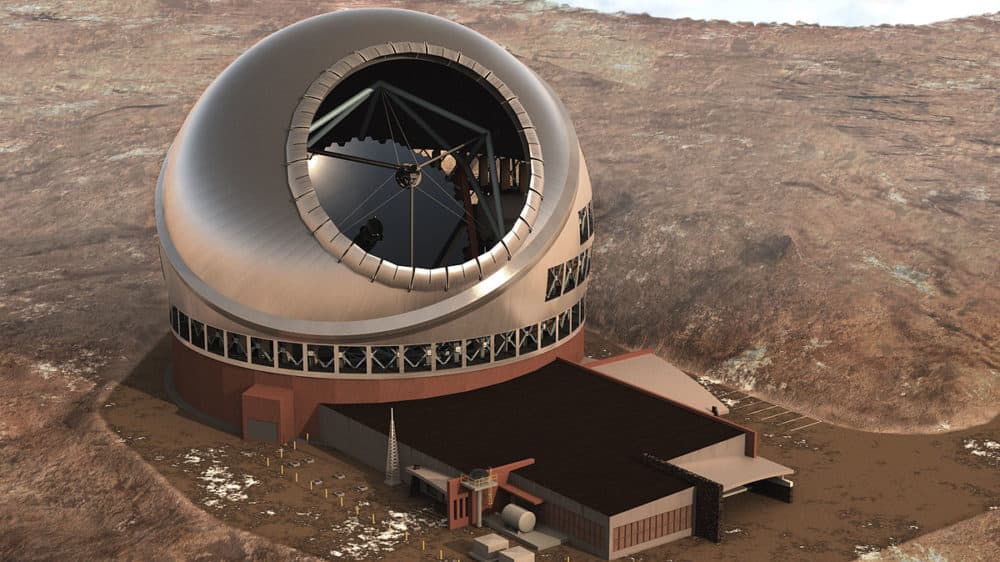Advertisement
Indigenous Hawaiians Weigh In On Controversial Thirty Meter Telescope
Resume
After years of protests and litigation, the Supreme Court of Hawaii has approved a permit for the controversial Thirty Meter Telescope, or TMT, to be built on the summit of Mauna Kea, a dormant volcano sacred to many Native Hawaiians.
The Thirty Meter Telescope will be the world's second-largest telescope, and allow astronomers to peer into the early years of the universe — some 13 billion light years away.
"That's the name of the game in astronomy if you're trying to learn about the past," says Mailani Neal, an Indigenous Hawaiian who's working toward her undergraduate degree in physics and dreams of someday working in the telescope. She tells Here & Now's Elise Hu that Mauna Kea is the perfect place to conduct astronomical research, and that Hawaiians were "born to navigate the unknown."
But other Kanaka Maoli, or Indigenous Hawaiians, say that such knowledge shouldn't come at the expense of Hawaiian spirituality.
"We see Mauna Kea as a space that belongs to [our gods], not to humans," says Makana Kushi (@haymakana), who opposes the construction of the observatory.
Interview Highlights
On why Mauna Kea matters to Indigenous Hawaiians
Makana Kushi: "Mauna Kea is sacred to a lot of Hawaiians who still believe that our akua — or gods, I think would be the closest English word to describe them — live there. Not because they're sort of ... humanoid beings that are standing on the mountain and living their lives every day, but that these ecosystems are manifestations of these spiritual beings.
"Putting a telescope on the summit to me is really disrespecting these akua. And also, and I think these two things are related, the ecosystem there is very gentle. There's a really specific climate on Mauna Kea that the bugs there, that the water there, that the plant life there require. And with a lot of building, they won't survive."
On what makes Mauna Kea an ideal place for astronomical research
Mailani Neal: "There have been scientific studies done on the situation surrounding Mauna Kea — aspects like water vapor levels, atmospheric turbulence, are just much more pristine than anywhere else in the world. Also, the fact that there's not much light pollution [on Mauna Kea] at all. That's starting to become a really big issue. They've actually had to designate dark sky reserves. So to have a place that is already in the perfect condition for astronomy is most ideal."
On the argument that the TMT is a natural extension of traditional Hawaiian star knowledge
Kushi: "These astronomers, they like to connect what they are doing as Western scientists to ancient Polynesian voyaging. Our people used the stars to navigate and to find their way to Hawaii. And I think it's a very surface-level connection. A lot of the knowledge that will come from the Thirty Meter Telescope is not knowledge that will be trickled down to working class Hawaiians, it's knowledge that will be in journal articles and help the careers of STEM Ph.D.s."
On advantages the Thirty Meter Telescope offers, and what people will be able to see with it
Neal: "The most obvious answer is the mirror size. With a bigger mirror, we can see further. We would also be able to see things with much more resolution. We would be able to see planets outside of our solar system."
On the argument that building an observatory on Mauna Kea would desecrate the land
Neal: "I've worked on the mountain for the past two summers and all the staff that work at these observatories hold the mountain in such deep reverence. They love the mountain just as much. TMT itself would be a zero-waste facility. They've gone through the environmental impact."
On framing this controversy as Indigenous spirituality versus technology
Neal: "Well a big problem I see with that is, not all Native Hawaiians are against the TMT. And on top of that, Hawaiians knew so much about the land and animals and about astronomy, too, from observing. And that is the root of science."
Kushi, on whether she plans to continue resisting the construction of the TMT
Kushi: "I absolutely do. People have stated already that they're willing to get arrested again, that they're willing to put their bodies between people who are seeking to construct TMT and the sacred space. And I support this 100 percent."
Savannah Maher produced and edited this interview for broadcast and adapted it for the web.
Correction: An earlier version of this post stated the Thirty Meter Telescope will allow astronomers to see 13 million light years away. In fact, it will allow them to see 13 billion light years away. We regret the error.
This article was originally published on November 13, 2018.
This segment aired on November 13, 2018.